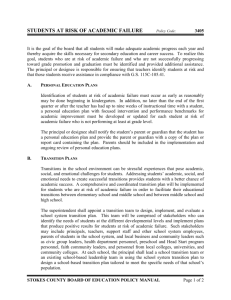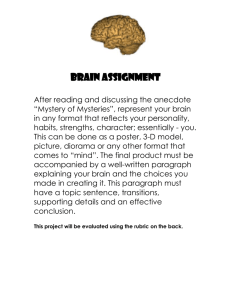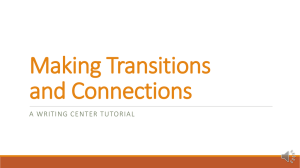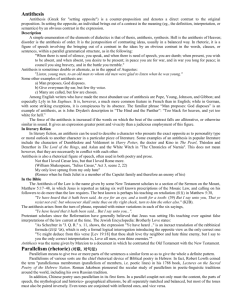Stylistic devices
advertisement
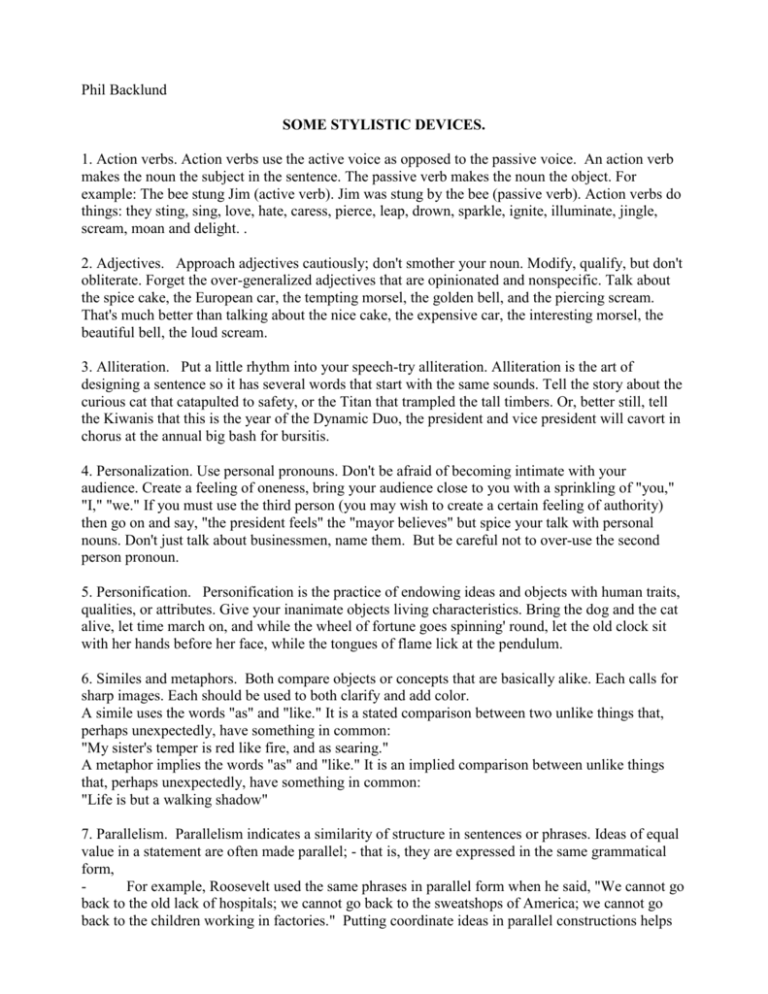
Phil Backlund SOME STYLISTIC DEVICES. 1. Action verbs. Action verbs use the active voice as opposed to the passive voice. An action verb makes the noun the subject in the sentence. The passive verb makes the noun the object. For example: The bee stung Jim (active verb). Jim was stung by the bee (passive verb). Action verbs do things: they sting, sing, love, hate, caress, pierce, leap, drown, sparkle, ignite, illuminate, jingle, scream, moan and delight. . 2. Adjectives. Approach adjectives cautiously; don't smother your noun. Modify, qualify, but don't obliterate. Forget the over-generalized adjectives that are opinionated and nonspecific. Talk about the spice cake, the European car, the tempting morsel, the golden bell, and the piercing scream. That's much better than talking about the nice cake, the expensive car, the interesting morsel, the beautiful bell, the loud scream. 3. Alliteration. Put a little rhythm into your speech-try alliteration. Alliteration is the art of designing a sentence so it has several words that start with the same sounds. Tell the story about the curious cat that catapulted to safety, or the Titan that trampled the tall timbers. Or, better still, tell the Kiwanis that this is the year of the Dynamic Duo, the president and vice president will cavort in chorus at the annual big bash for bursitis. 4. Personalization. Use personal pronouns. Don't be afraid of becoming intimate with your audience. Create a feeling of oneness, bring your audience close to you with a sprinkling of "you," "I," "we." If you must use the third person (you may wish to create a certain feeling of authority) then go on and say, "the president feels" the "mayor believes" but spice your talk with personal nouns. Don't just talk about businessmen, name them. But be careful not to over-use the second person pronoun. 5. Personification. Personification is the practice of endowing ideas and objects with human traits, qualities, or attributes. Give your inanimate objects living characteristics. Bring the dog and the cat alive, let time march on, and while the wheel of fortune goes spinning' round, let the old clock sit with her hands before her face, while the tongues of flame lick at the pendulum. 6. Similes and metaphors. Both compare objects or concepts that are basically alike. Each calls for sharp images. Each should be used to both clarify and add color. A simile uses the words "as" and "like." It is a stated comparison between two unlike things that, perhaps unexpectedly, have something in common: "My sister's temper is red like fire, and as searing." A metaphor implies the words "as" and "like." It is an implied comparison between unlike things that, perhaps unexpectedly, have something in common: "Life is but a walking shadow" 7. Parallelism. Parallelism indicates a similarity of structure in sentences or phrases. Ideas of equal value in a statement are often made parallel; - that is, they are expressed in the same grammatical form, For example, Roosevelt used the same phrases in parallel form when he said, "We cannot go back to the old lack of hospitals; we cannot go back to the sweatshops of America; we cannot go back to the children working in factories." Putting coordinate ideas in parallel constructions helps the listener to follow your direction more easily and helps the speaker avoid shifts in person and tense. 8. Antithesis. Antithesis is a type of parallelism, in which the construction is balanced but the ideas are opposing. For example, in his inaugural address John F. Kennedy used antithesis when he said, "Let us never negotiate out of fear. But let us never fear to negotiate," And in his first inaugural address, Richard M. Nixon said, "We cannot expect to make everyone our friend, but we can try to make no one our enemy." 9. The rhetorical question. How often has someone said to you, - "You don't really expect an answer to that question"? And you should honestly answer, "No, it's just a device to create interest I'm merely introducing an idea in the form of a question. I want to stimulate your interest." Or your mother says, "What's going to become of you?" Or you stand up at the podium and say, "Consider the recent rise in crime in our city. Where will it lead? Where can it lead?" And your audience nods their collective heads and thinks, "True, true, where will it all lead?" You are really introducing an idea, and you use the question form to lead the audience to listen and perhaps probe with you. 10. Restatement and repetition. Your listeners may not always understand your meaning or appreciate a clever phrase the first time you say it, so you may wish to reiterate or amplify a statement to be sure you got your idea across. Restatement is used to clarify and emphasize; it says the same thing over again in a different way. A speaker at a Press Club meeting restated his point in the following manner. "The fledgling reporter needs to listen to the editor who says that the three most important things to remember in any story are accuracy, accuracy, and accuracy. I believe that accuracy is of primary importance and that every fact needs checking. " " " PHIL BACKLUND STYLE IN PUBLIC SPEAKING I. WHAT IS STYLE? It is the manner is which the language in a speech is developed. Style adorns content, reasoning, and arrangement. . A. Style is personal: The style a person develops and uses reflects his/her manner of expressing thought through language in a way that best reveals feelings and personality, in light of the audience and speaking situation. B. Style is purposeful: It's influenced by your own purpose for being in the speaking situation. Ideally, the style you develop will serve your purpose when effectively conveyed within the total speaking situation. II. BASIC ELEMENTS OF EFFECTIVE STYLE: (CLARITY AND IMPRESSIVENESS): A. There are certain qualities that good style works to convey: 1. strength 2. vigor 3. vividness . 4. liveliness (present tense; "You are there" approach) 5. accuracy (to the point) 6. economy (few words/simple choice of words) 7. propriety (appropriateness to subject matter and audience) B. CLARITY: How clear you make yourself understood thru use of language. Clarity in style is achieved thru coherence, emphasis. and directness. 1. Coherence: the logical relationship of ideas in the speech, achieved by: . . a. Keeping related ideas together (organization) b. Maintaining clear and logical transitions (described later). c. Using a grammatical structure, which fits the audience. d. Repetition of a key 'Word or phrase, to keep it foremost in the audience's thinking. 2. _Emphasis: treating your material according to its significance, stressing the more important points. subduing lesser points. a. Sentence length effects emphasis; lengths of sentences should be well mixed within the speech. 1. simple sentences: a. brief b. easy to understand . c. make a point seem strong 2. compound sentences: a. effect of piling up one idea on another b. building, climactic. 3. complex sentences: . . a. more difficult to use for emphasis, since they contain more ideas. b. can have: 1. piling up effect 2. parallel language 3. contrast ideas in one sentence 3. Repetition of words effects emphasis, and requires good judgment. a. Repetition of key words and phrases lock thoughts and impressions into listeners memories. b. Repetition of the major theme keeps it continually in mind within the context of the speech. c. Language use: vivid and colorful language. helps emphasize (more later). 4. Directness: A passage in a speech can’t be re-heard like a passage in a "book can be reread; so in speaking you must be direct and easy to follow. a. Unnecessary wordiness should be avoided_1. Elucidate/explain 2. Deleterious/injurious 3. Isagogic/introductory 4. Inebriated/drunk b. Avoid ambiguities. The denotative meanings of your words should be as clear as possible. c. Avoid gobbledygook: (During F.D.R's term, a bureaucratic statement came to him, saying “It is evident that a substantial number of persons within the continental boundaries of the US have inadequate financial resources with which to purchase the products of agricultural communities and industrial establishments. It would appear that for a considerable segment of the population, possibly as much as 33% of the total, there are inadequate housing facilities and an equal1y significant proportion is deprived of the proper kinds of clothing and nutriment.” FDR. wanted to use this material in a Presidential address, and in fact did, translating it to this: "1 see 1/3 of the nation illhoused, ill-clad and ill-nourished.” d. Be economic in your speaking, avoid using several illustrations when one would be suffice. e. Be specific. 1. Naming people instead of general references helps. 2. Be specific when referring to time and place (“450 miles" not a good day's drive). f. Use words with connotative meaning that give direction to an idea. 1. Residence: bungalow, penthouse, apartment; shack, hutch. 2. Study: cram, review, skim, memorize C. IMPRESSIVENESS: The 2nd element of style 1. Impressiveness helps to: a_ Fix ideas more firmly it) the mind of the listener b. It refers .to those qualities of language which heighten or intensify effects upon the mind or feelings. Two basic ways of achieving impressiveness: imagery and figures of speech. c. Imagery: the quality of words to evoke mental pictures or the creation of heightened perception in the senses through the use of words. Images should be appropriate, that is, they should appeal directly to the point being made. 1. Visual (flag) "The clear colors of deep red, pure white, and royal blue. 2. Auditory images a. "Cannons to the right of the, cannons to the left of them. cannons in front of them." b. (music) the jarring crash of the guitar echoed through the room." 3. Olfactory images: (caves) "The cool dark eerie smell of unexplored caves.” 4. Tactile images: (babies) "A baby skin: soft, tender, warm, and smooth." 5. Taste images: (coffee) "The full. aromatic flavor of New Orleans coffee." d. Figures of Speech: add an extension of meaning to literal language. They make ideas stronger and more long lasting in the mind of the listener. 1. Resemblances: figures of speech based on resemblances suggest common characteristics of otherwise dissimilar things. ' a. Simile: direct comparison of two things using a connective word (ex. Like, as, as if) 1. "Cultivation of the mind is as necessary as food to the body." b. metaphor: a more concise comparison, describing two or more things as being the same: 1. "Cunning is the dwarf of wisdom." 2. Analogy: a train of thought is developed concerning one thing, and then similarly developed about the speaker's matter of concern. 3. Personification: applies human or personal qualities to inanimate objects or abstractions . , a. "The motor died" b_ "Genius is always impatient of its harness.” 4. Contrasts: figures of speech making comparisons of opposing concepts designed to stimulate interest or clarify the familiar. 5. Antithesis:. sets. one concept in direct .contrast with another. a. "as different as day and night." b. "when reason is against a person, she will be against reason." 6. Epigram: forceful statements designed to say much in a few words and to convey finality. " a. “Poverty does not mean the possession of little, but the non-possession of much.” 7. Hyperbole: 'Exaggeration of language for effect, not to be taken literally; overemphasis to drive a point home. a. “savage”/unrefined b. “infinite”/ many 8. Rhetorical question a. Either a question where the answer is implicit in the question, and no answer is necessary. (political) “Do you want as governor a man of power and experience who has shown his knowledge of the problems and his desire to work with the people?" b. A point of transition; the next logical point can be introduced with a question. 9. Climax: series of items arranged in an order of increasing force until it attains a peak level of intensity. whereby the desired message is completed. PAUSES: Beginning speakers are often very afraid of silence (uh, um, and stuff). We should learn that silence is not something to completely avoid. Well-timed silence can be very effective. It's good to learn to handle pauses. Uses of pauses: 1. separate ideas (usually major points). 2. Indicate a transition from one point to the next. 3. Emphasis: they can center attention on a specific point; the audience is given time to fully comprehend the impact of a strongly made point. TRANSITIONS: Are words or phrases, which join ideas together in a speech (usually the main ideas). Clear and logical transitions better enable the listener to follow how one idea is connected to another. Transitions can be word, a short phrase, or a sentence or two. Functions of transitions. A good transition should: 1. Show that the speaker is moving from one idea to another 2. Indicate when an idea has been completed. 3. Indicate relationships between ideas of concern. 4. Remind the speaker of his sequence of thought. One-word or short-phrase transitions help add coherence to a speech. Transitions may be used as: 1. Expressions indicating that something new is to follow or a conclusion will be drawn. a. "next..." b. "and so..." c. "as a result..." d. "When this has been done…” e. "And so, you see that…" 2. Expressions indicating that additional material to a point just made will follow. a. "also…” b. "furthermore..." c. "likewise..." d. "in addition to... “ 3. Expressions indicating a change in direction. a. "but... “ b. "however.. .” c. "on the other hand..,," d. "nonetheless..." e. “in contrast to …” 4. Expressions indicating a concession. a. “although…" b. "while... “ 5. Expressions to enlarge or extend a point. a. "in other words..." b. .'for this reason... “ c. “for example".." d. "naturally..." Transitions can also appear as whole sentences: 1. "In addition to... there is another important aspect of .." 2. "We have seen how ….next we want to see how….” 3.. "Since……is so. what can be said about…." Avoid much repetition of transitions and try to use more than the most common such as “and" and "also.” Work for variety in your transitions. Phil Backlund PARALLEL PHRASING. Use the same sentence structure and a similar type of phraseology in a series of main points. Since main points are parallel units of a speech, they' can be worded so they sound parallel. Use the repetition of words, phrases and sound to create the phonetic sensation of parallelism. Instead of wording a series of main points thus: I. The amount of your income tax depends on the amount you earn. II. Property tax.is assessed on the value of what you own III. You pay sales taxes in proportion to the amount you buy. Phrase them like this: I. Your possessions determine your property tax. II. Your purchases determine your sales tax. III. Your earnings determine your income tax. Note that a part of each statement in the series above was repeated, while the rest of the statement changed from point to point. Such repetition is done to intensify the parallelism. Parallel phrasing is seen in the following examples. ._ Thesis: The drug ecstasy is a threat I. Physically . II. Mentally III. Genetically Thesis: How do we define pornography? I. The dictionary definition II. The religious definition III. The legal definition Thesis: Let's look at Cancer I. Kinds II. Causes III. Cures.





